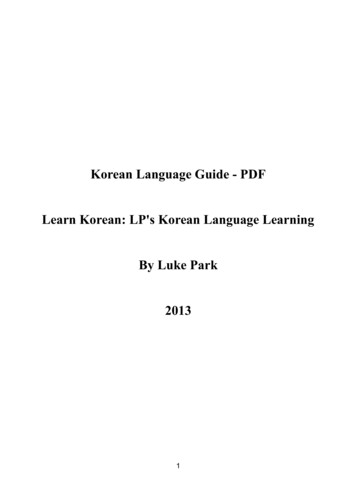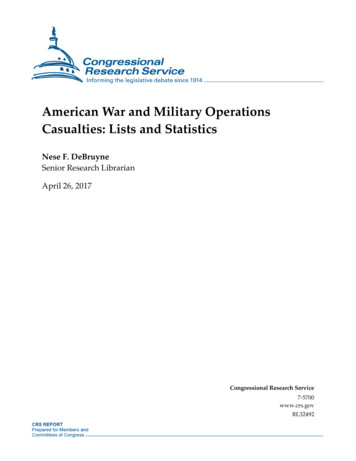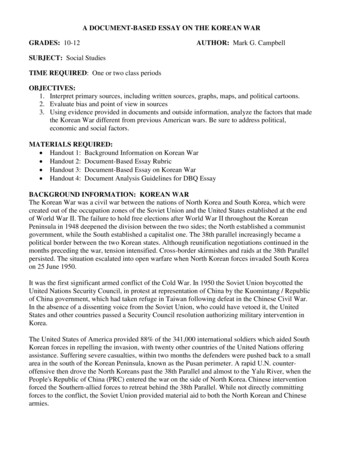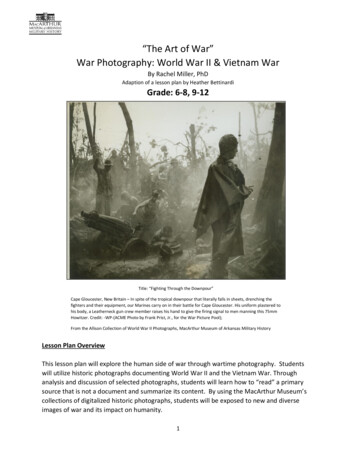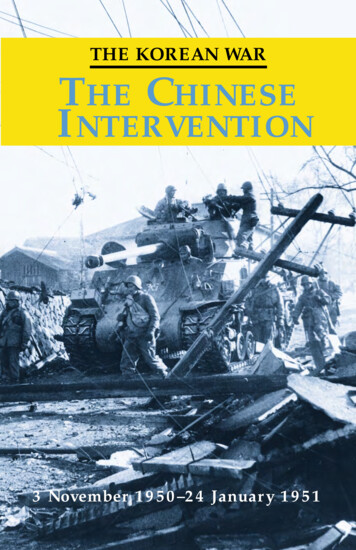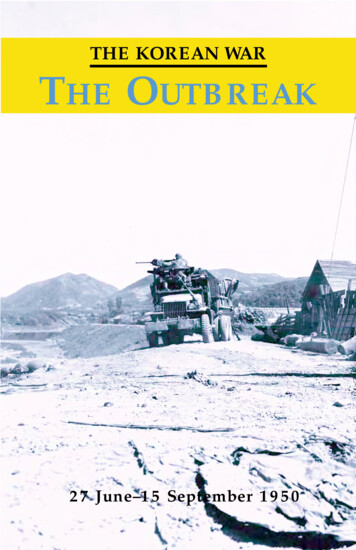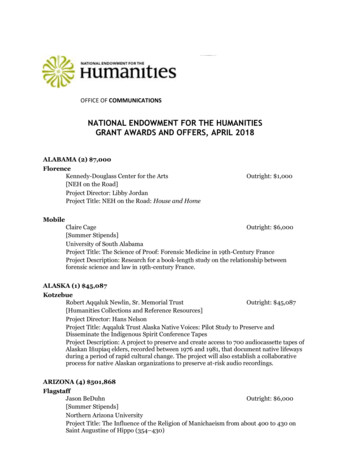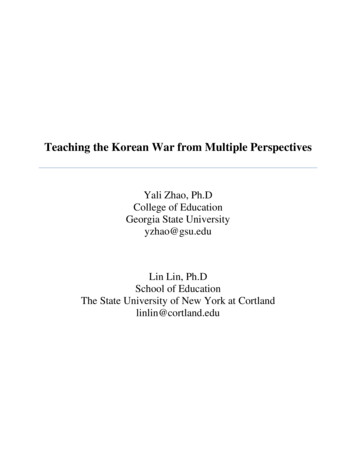
Transcription
Teaching the Korean War from Multiple PerspectivesYali Zhao, Ph.DCollege of EducationGeorgia State Universityyzhao@gsu.eduLin Lin, Ph.DSchool of EducationThe State University of New York at Cortlandlinlin@cortland.edu
Teaching the Korean War from Multiple Perspectives“Technically, the Korean War continues today, as only an armistice agreement haltedthe fighting in 1953. The Korean peninsula remains one of the world's mostdangerous flash points, and the West knows less about the Democratic People'sRepublic of Korea (North Korea) than about any other nation on earth. The intentionsand behavior of its leaders remain shrouded in mystery. To maintain the uneasyarmistice, some 37,000 U.S. troops remain in the Republic of Korea. A solution to theKorean problem seems as far off as ever.”- Spencer TuckerIntroductionHistory is typically mandated in schools throughout the world. One of the primarymissions of history, more than any other subject in the school curriculum, is to offerunprecedented opportunities for students to cultivate a sense of national identity, heritage andcommon values. Across international settings, history textbooks are the primary source for theyoung people to obtain knowledge about the history of their own country as well as the otherparts of the world (Foster and Nicholls, 2005, p. 214-243). Hein and Selden (2000) suggestedthat school history textbooks are central to the transmission of national values in most societiesin that they present an “official” story highlighting narratives that shape contemporarypatriotism. Therefore, many countries’ debates over the content and format of history textbooksare sites of considerable educational and political conflict (Foster and Crawford, 2006). Forexample, in April, 2005, reactions to the distorted content about Japanese atrocities in WorldWar II found in Japanese textbooks were strong in Asian countries, with widespread protestserupting inside and outside Japan, particularly in China and South Korea (Zhao and Hoge, 2006,p. 422-428).2
In recent decades, history scholars have been challenging the nature of knowledgepresented in history textbooks by asking “Whose knowledge is of the most worth?” (Apple andChristian-Smith, 1991, p. 12-19; Loewen, 1995, p. 266-270). They wondered what kind ofhistorical knowledge teachers should present to young students (Zhao and Hoge, 2006).Textbook analysis has been used by scholars and classroom teachers to help students develophistorical thinking (DeRose 2007, p. 36-39; Gordy, Hogan, and Pritchard, 2004, p. 80-91).Comparing international textbooks to examine how past events involving several countries wereviewed by these and other nations has become a desirable approach to help students analyzehistorical events from different points of views and identify bias in historical accounts intextbooks. (DeRose, 2007, p. 36-39; Lindaman and Ward, 2004, p. 18; Loewen 1995, p. 266267).A number of studies have examined different countries' textbooks, reviewed textbooksfrom a bilateral perspective, and analyzed other countries’ cultures and historical events to showthe influence of textbooks on information that is taught in schools about other cultures. Manyresearchers around the world have critiqued textbooks for the last 30 years by assessing clarity ofwriting, the effectiveness of the format or design, and authors’ biases or political perspectives inexplaining historical actors or events. Examination of textbook content and selection processesoffers intriguing and illuminating points of contrast that help critics better understand howhistory is used and portrayed in different national settings. In this global age, internationaltextbook research and analysis has become a crucial means of promoting increased cross-culturaland international understanding, and also as a way of constructing more tolerant and accurateversions of shared individual and institutional pasts (Altbach, 1991, p. 242-258).3
No doubt, the Korean War is a war that deserves close and continued study because of itscomplexity and its tremendous impact on the six countries involved in the war. For centuries theKorean War remained as the “Unknown War” or “Forgotten War” in the history of the UnitedStates (Blohm, 1999; Edwards, 2000; Tucker, 2000), although the war had a profound impact onthe six countries involved. For both North and South Koreans, the war brought catastrophiccivilian and military casualties and resulted in the continued division of their country. For theChinese, the war was the first military operation that the communist government launched afterthe foundation of the People’s Republic of China in 1949. The Chinese believed that theydefended both North Korea and China against imperial aggressors (Chinese History, 2002). ForAmericans, the war found the United States being haunted by fears of Chinese militaryintervention based on misconceptions born in the Korean War of that nation’s military power(Nichols, 2000, p. 89-112; Tucker 2000, p. 3-5). The military conflicts stiffened U.S. attitudestowards the People’s Republic of China. For the former Soviet Union, the war was just anotherfront, on which the former Soviet Union and the United States endured a high tension face-off(Lindaman and Ward, 2004, p. 266-267). The Soviet Union supported North Korea by providinglimited assistance in the form of combat advisors, weapons, and military pilots. For Japan, itseconomic development owes much to the American military orders during the war and militaryaids after the war (Stubbs, 1999, p. 337-355). As the citation by American historian SpencerTucker (2000) indicates at the beginning of the article, the Korean War continues today, as onlyan armistice agreement that halted the fighting in 1953. To maintain the uneasy armistice, largeAmerican troops are still stationed in South Korea today.The topic of the Korean War provides history teachers with a challenging yet perfectopportunity to teach about a historical event and its current impact from multiple perspectives to4
develop students’ critical and historical thinking skills. Teachers should address rather than avoidthis topic, because the Korean War was a turning point in twentieth-century history, the firstshooting confrontation of the Cold War, the first limited war in the nuclear age, the only timesince WWII that two of the world's major military powers, the United States and China, havefought one another (Spencer Tucker, 2000).The authors of this paper strongly recommend that history teachers adopt the comparativeapproach of analyzing international history textbooks about complex controversial events thatmight have involved multiple countries such as the Korean War. We firmly believe thatpresenting multiple perspectives of the same historical events highlights the development ofstudent critical thinking and reasoning skills and global awareness, which are goals and keycomponents of history curriculum.The authors of this article have worked with professors from Japan and South Korea inthe past two years using a comparative textbook analysis approach to understanding the KoreanWar based on the textbooks adopted in public schools in the United States, South Korea, NorthKorea, Russia, Japan, and China. We analyzed versions of textbooks used in middle schools ofthese six countries to examine the Korean War. The comparative analysis focused on four areas:the causes of the Korean War, American involvement in the war, Chinese involvement in the war,and the results of the war. Analysis of the central story lines revealed that there exist someconsistent statements about certain events in the Korean War, but inconsistencies and conflictingviews seem to dominate the history textbooks in these countries.As far as causes of the Korean War are concerned, textbooks in these six countries fallinto two different views. At one side, the U.S., Japanese, the Soviet Union and South Korean5
textbooks agreed that the communist North Korean invaded or attacked South Korea. At theother side, Chinese and North Korea textbooks provided a different account that North Koreawas invaded by the South Korea troops backed up by the United States.The explanation of how the Americans got involved in the war in the textbooks of theU.S. and South Korea implies that the weakened South Korea solicited U.S. military assistancewhen facing North Korean attack. U.S. troops stepped in mainly because they wanted to preventthe expansion of communist countries led by the Soviet Union. North Korea textbook states thatAmerica condemned North Korea as aggressors and ordered the North Koreans to withdrawbeyond the 38th Parallel. Neither Chinese, Japanese, nor Russian textbooks offered reasons forAmerican involvement. Textbooks in all six countries recognized the involvement of the UnitedNations mainly made up by the U.S. troops.As for the reasons for Chinese involvement, all the nations except North Korearecognized the fact that UN forces approached Chinese border, which was considered a securitythreat by the Chinese government, and as a result China sent voluntary troops to join NorthKorean army. Chinese textbooks made it clear that China got involved in the war to defend itshomeland because UN forces not only threatened the security of Northeast China but alsoinvaded Chinese territory. Besides, the North Korean government asked for military aid fromChinese government as South Korea sought help from the United States. Textbook in Russiaindicates that the fighting between the U.S. and the Soviet Union was mainly engaged in the air.The analysis of textbook treatments of the Korean War in these six countries shows thateach nation’s textbook stresses its own perspective and largely ignores the horrors of the war.Middle school level history textbooks almost universally overlook the casualties and damage the6
wars had inflicted upon individual civilians and the nations as a whole. The war brought aboutcountless deaths and immense property damage. The total number of casualties suffered bySouth Korea alone amounted to about 1,500,000 causing a great number of war orphans anddisplaced families. Virtually all of the U.S. history textbooks put the U.S. death figure at 50,000soldiers. Only a few U.S. textbooks mentioned the casualties of South Korea and none gaveestimates of the death toll of the Chinese soldiers. The Chinese textbooks did not give thenumber of Chinese soldiers killed in the Korean War.There is little talk of glory in the U.S. textbooks about the result of the war. Theaftermath of the war is neglected in about 50% of the books reviewed in the United States. Oneversion of the textbooks in the United States acknowledged that the war ended in stalemate.General Dwight D. Eisenhower, who was elected as president in 1952 and took office in 1953,agreed to a compromise to end the war during truce talks with North Korea and China. Japaneseand Russian textbooks stated that the war continued with regional battles from 1951 until July1953 when a cease-fire agreement was reached. Chinese textbooks hailed their victory in the warof defending China and North Korea against the United States. All Chinese textbooks accreditedthe signing of the cease-fire to the joint efforts and patriotic spirits of Chinese People’sVolunteer Army and the North Korean Army. They declared that China and North Korea wonthe war against aggressors. North Korea declared their victory in their textbooks but did notmention Chinese’s contribution. The South Korean textbook depicted the end of the war with atruce signed by UN-South Korean forces and North Korea in July, 1953. The textbook came to aconclusion that “the war, caused by North Korea, was a tragedy and a challenge to freedom andpeace.” North Korean and South Korea textbooks emphasize the war casualties and damage to7
Korean people. Russian textbook talks about the war casualties and damage to all the countriesinvolved.The following textbook excerpts about the Korean War are taken from middle schooltextbooks of the six countries involved in the Korean War. History teachers can use theseexcerpts to help students better understand how the same historical event was depicted andperceived in different countries. We suggest that teachers divide the class into six groups andeach group read textbook excerpts from one nation and then present the different perspectives interms of the cause of the war, reasons for American and Chinese involvement in the war, and theresult of the war (see Appendix).ReferenceAltbach, P. (1991). Textbooks: The international dimension. In The politics of the textbook, ed.Michael Apple & Linda Christian-Smith, 242-258. New York: Routledge.Apple, M. and Christian-Smith, L. 1991. The politics of the textbook. New York: Routledge.Blohm, C. (1999). The forgotten war. Cobberstone. d on July 2, 2008).DeRose, J. (2007). Comparing international textbooks to develop historical thinking. SocialEducation, 71(1), 36-39.Edwards, P. (2000). To Acknowledge a War: The Korean War in American Memory. GreenwoodPress.Foster, S. & Nicholls, J. (2005). America in World War II: An analysis of history textbooksfrom England, Japan, Sweden, and the United States. Journal of Curriculum andInstruction, 20 (3), 214-233.Foster, S. (2006). Whose history? Portrayal of immigrant groups in U.S. history textbooks,1800-present. In What shall we tell the children? International perspectives on8
school history textbooks ed. Stuart Foster and Keith Crawford, 155-178. Greenwich:Information Age Publishing.Gordy, L., Hogan, J. & Pritchard, A. (2004). Assessing “Herstory” of WWII: Content analysis ofhigh school history textbooks. Equity & Excellence in Education, 37, 80-91.Hein, L. & Selden, M, (2000). Censoring history: Citizenship and memory in Japan, Germany,and the United States. M.E. Sharpe.Lindaman, D. & Ward, K. (2004). History lessons: How textbooks from around the worldportray U.S. history. New York City: The New Press.Loewen, J. (1995). Lies teachers told me: Everything your American history textbook got wrong.New York City: A Touchstone Book. Simer & Schuster.Nichols, M. (2000). The Chinese communist intervention in the Korean War: An exercise inanalyzing documents. Magazine of History, 14(3). 37-39.Roberts, P. (2000). New Light on a "Forgotten War": The Diplomacy of the Korean Conflict.Organization of American Historian (OAH) Magazine of History, .htmlStubbs, R. (1999). War and economic development: Export-oriented Industrialization in East andSoutheast Asia. Comparative Politics, 31(3), 337-355.Tucker, S. (2000). Why Study the Korean War? Organization of American Historian (OAH)Magazine of History, 14(3). hao, Y. & Hoge. J. (2006). Countering textbook distortion: War atrocities in Asia, 1937-1945.Social Education, 70(7), 422-428.9
AppendixA: Textbook Excerpt from North Korea (Translated from North Korean History Textbook)Since 1947, the American imperialists have continuously staged many military invasionsand they did the attacks 1,863 times in 1949 alone. The American imperialists have alreadyplanned to invade North Korea in 1949. However, when the enemies have been defeated byNorth Korean forces, they have to change their “plan of conquering the north” radically.On January, 1950, the Secretary of the U.S. Army Kenneth C. Royal, the bastard,sneaked into South Korea and directed their “plan of conquering the north.” On February,Douglas MacArthur, the bastard, asked Lee, Sung Man, the insurgent, and the puppet Chief ofStaff, the bastard, of South Korea to come to the United States’ Far East Command (FECOM)and commanded them to attack North Korea specifically.On June 9, 11, and 13, the American imperialists created an awe-inspiring waratmosphere all over the south and along the 38th Parallel by proclaiming a Special InspectionGuard Decree, a National Emergency Decree, and a Semi-National Emergency Decreerespectively. Crept into South Korea on June 18, a special envoy John Foster Dulles, with theU.S military advisors and high-ranking military officers of South Korea, inspected along the38th Parallel and allowed to execute the “plan of conquering the north” in a foxhole near thefoxhole near the line. He ordered Lee, Sung Man, the thief, to attack the north on June 25,1950.Dulles, the bastard, ordered his staff to make counterpropaganda that North Koreainvaded the south first on July 25 and to attack the north. On the basis of careful plans andpreparations, the American imperialists provoked the aggressive war on June 25, 1950. (pp. 1819)On June 25, 1950, the American imperialists ordered puppet South Korean forces toattack the north and from the early morning of June 26 the U.S. Marines were mobilized andon June 27, Truman ordered the U.S. Navy and the U.S. Air Force to engage the war. Afterthat, the American imperialists, embarrassed by the counterattack of the North Korean forces,10
ordered the U.S. Army to call out. (p. 19)The American imperialists convened their allies to make an illegal resolution andcondemned North Korea as aggressors, and ordered the North Koreans to withdraw beyond the38th Parallel. The American imperialists formed U.N. forces with troops provided by theUnited States and 15 other puppet nations. The determination has already been made by theAmerican imperialists beforehand. Therefore, the U.N. forces were formed. (p. 21) .About 1,500 of modern airplanes such as the B-29, called Superfortress, were used in theearly period of the war, over 10,000 in the last period of the war. The American imperialistcommitted criminal acts by using such weapons of mass destruction as biological weapons andchemical weapons.According to an American imperialists’ shortened report, at the very least, about4,000,000 U.S. aggressors engaged in the Korean War. During the Korean War, the Americanimperialists spent 20,000,000,000 dollars of war expenditure. War supplies amounted to over73,000 tons, 11th times of the supplies during the Pacific War. During the three-year period ofwar, the American imperialists appointed killer generals such as MacArthur, Ridgway, Clark,Walker, Almond, Vanfleet, Taylor, and Dean. (p. 20)The American imperialists used cruel and barbaric tactics during the Korean War.Representative tactics are surprise attacks, large-scale landing operations, massive concentratedattacks, and scorched-land strategy. (p. 21) With the defeats of the American imperialists in the war, on June 1951, in spite of beinga super power, the American imperialists suggested a cease-fire agreement. Through the talk,the bastards tried to gain a “glorious” cease-fire by realizing their aggressive purposes. Whenthe talk did not work, they provoked last-ditch massive attacks and threatened to use atomicbombs. However, their maneuvers were crushed by North Korea. The American imperialists,knelt down to North Korean peoples, were reluctant to sign the cease-fire agreement.The representative massacre of people in Sincheon was committed by the Americanimperialists using cruel methods . Hundreds of thousands of people were killed in NorthKorea by shooting, beating, hanging, skinning, dismembering, burying alive, cutting tongues11
and breasts and so forth. In the south, about 1,000,000 of people were massacred by theAmerican imperialists. They used atomic bombs and biological weapons to kill North KoreanPrisoners of War (POWs).The bastards destructed and plundered about 8,700 of factories, over 600,000 ofhouses, 5,000 of schools, thousands of hospitals, huge rice paddies, 6,700 of historical relics.During the four month period of the war in the south, about 50 cities and 12,400 of farmingvillages were burned to the ground. (p. 21-23)Teacher’s Note: This is a passage selected from North Korean Textbook entitled “The Americanand Japanese Imperialists’ Evildoing of Korean Invasion”. Education Books. (2005).B. Textbook Excerpt: South Korea (Translated from South Korean History Textbook)When the overthrow of the South Korean government through social confusion became toodifficult, the North Korean communists switched to a stick-and-carrot strategy: seeming to offerpeaceful negotiations, they were instead analyzing the right moments of attack and preparingthemselves for it.The North insisted on political negotiations between the leaders of the South and the Northaiming toward a constitution of a unified government, and openly publicized their policy. By thattime the American forces stationed in the South withdrew and announced that the peninsularwould be excluded in America’s first line of defense in the Far East. Taking advantage of thissituation, the North Korean communists prepared themselves for war. Kim Il-sung secretly visitedthe Soviet Union and was promised the alliance of the Soviets and China in case of war.Finally, at dawn on June 25th, 1950 the North began their southward aggression along the38th parallel. Taken by surprise by these unexpected attacks, the army of the Republic of Korea(South Korean) fought courageously to defend the liberty of the country. But with the lack ofsoldiers and equipment, Seoul had to surrender and the South Korean forces were forced to retreatto a battle line south of the Nak-dong river. The armed provocation of the North Korean12
communists brought the UN Security Council around the table. A decree denounced the NorthKorean military action as illegal and as a threat to peace, and a decision was made to help theSouth. The UN army constituted of the armies of 16 countries – among them the United States,Great Britain, and France – joined the South Korean forces in the battle against the North.Teacher’s Note: This passage is selected from Kim, Doojin’s Korean History: Senior High.Seoul: Dae Han Textbook Col, 2001, p. 199.C. Textbook Excerpt: The United States. (Selected from American History Textbook)The first major proxy war erupted in 1950. At the end of World War II, the KoreanPeninsula was occupied by both American and Soviet troops. Unable to agree on what kind ofgovernment the Korean people should have, the superpowers divided the country. The Sovietsinstalled a communist government in North Korea, while in South Korea the Americansencouraged a government that favored capitalism.In 1950, North Korean troops armed with Soviet tanks and weapons overran most of theSouth Korea. Their goal was to unite the country under a communist government. PresidentTruman ordered the U.S. military to support South Korea. The United Nations also took actionby calling on member nations to assist South Korea. In all, 15 nations sent more than half amillion troops to Korea. More than 90 percent of the UN forces were American.The UN forces pushed the communist invaders back into North Korea almost as far as itsborder with China. At that point, 300, 000 Chinese soldiers poured into North Korea and drovethe UN troops back to South Korea. Fearing that the struggle in Korea could widen into a worldwar, Truman pushed for a peace settlement.The agreement ending the Korean War left Korea divided as it has been before the war.Americans were pleased that communism had been contained in North Korea without starting athird world war. But the costs of containment were high. About 54,000 Americans died in a war13
that cost the nation over 20 billion. More than a million Koreans also lost their lives.Teacher’s Note: This is a passage selected from the U.S. Textbook entitled “The United States.(2002). Teachers Curriculum Institute. 442.D. Textbook Excerpt: Japan (Translated from Japanese History TextbookWhile the Cold War was worsening, war finally broke out in 1950 between the Republic ofKorea and the Democratic People’s Republic of Korea (the Korean War). As the North Koreanarmy advanced southward rapidly, the U.N. Security Council, with the Soviet Union delegateabsent, decided to give military support to South Korea. The United Nations forces, consistingmainly of United States troops, advanced northward to near the Chinese-Korean border. Chinasent a powerful volunteer army to North Korea. Subsequently, fierce battles raged around the38th parallel; in 1953, a cease-fire agreement was concluded at long last.During the Korean War, American bases on the main island of Japan and on Okinawa wereused, and a vast amount of military supplies were procured in Japan. The effect was an upswingin the Japanese economy and a speeding of recovery.Teacher’s Note: This is a passage selected from Lindaman, D. & Ward H. (2004) HistoryLessons: How textbooks from around the world portray U.S. History p. 271. The particularpassage was selected from Japanese Textbook entitled “Japan in Modern History”. Tokyo:International Society for Educational Information, 1994, 183. 185.E. Textbook Excerpt: Russia (Translated from Russian History Textbook)Stalin sided on North Korean leader Kim, Il Sung, who tried to control the wholePeninsula. The Korean War was the first military confrontation. While the Soviet Unionsupported the north, the U.S. the south. The war broke out during summer in 1950 when the14
North Korean troops, armed with Soviet Union-made weapons, invaded the South Koreanterritory and they drove the enemies down to the far south of the Peninsular. (p. 189)Under the banner of the U.N., the U.S., prepared for military operations, hurried to supportthe south. On the fall of 1950, the U.S. troops attempted the large-scale landing operation inIncheon. The North Korean troops were in a position of defense by the U.S. troops. They wereforced to retreat to the 38th Parallel and the Peninsula was divided into North and South Koreaalong the 38th Parallel. The U.S. and South Korean forces pushed the Communist troops up tothe Chinese border. The U.S. military airplanes flew over the Chinese and Soviet Union’s borderareas. At Kim, Il Sung’s request, the Soviet Union’s military airplanes came to control the airfrom November in 1950. (p. 190)China involved in the war on November in 1950. About one million Chinese army,officially known as the Chinese People’s Volunteer Troops, pushed down to the 38th Parallel.The front was in a stalemate there. The nature of the war at the time was a war of position. WhileGeneral Douglas MacArthur tried to attack China with atomic bombs, President Harry Trumandid not allow the planned operation. He worried that the attack will cause the Soviet Union toinvolve in the war. Instead, the fighting between the U.S. and the Soviet Union was engaged inthe air. During the war, the aces of the Soviet Union shot down 1,300 of U.S. military airplanesand 345 vice versa. (p. 190)Truce talks, started in 1951, ended the war in 1953. The boundary line between North andSouth Korea was set near the 38th Parallel due to the cease fire. The first showdown between theU.S. and the Soviet Union during the “Cold War” period finished like that. (p. 190)Teacher’s Note: This is a passage selected from Russian Textbook entitled “Russia and theWorld”. (2005). Dropa Publishing Company.F. Textbook Excerpt: China (Selected from Chinese History �出版社15
The South Korean textbook depicted the end of the war with a truce signed by UN-South Korean forces and North Korea in July, 1953. The textbook came to a conclusion that "the war, caused by North Korea, was a tragedy and a challenge to freedom and peace." North Korean and South Korea textbooks emphasize the war casualties and damage to



